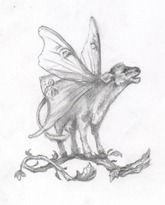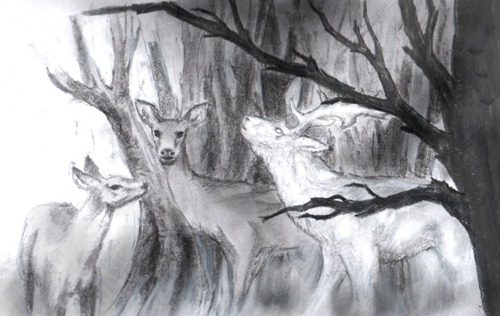St Hauda’s Land is home to many beasts and birds, as well as to rare creatures found nowhere else in the world. This little bestiary considers what some of them mean to the novel.
Narwhals
In the water huge, elegant bodies moved. A narwhal pod. Funny, she thought, how invisible such huge creatures could make themselves under only a little water. She remembered she had dived once between a mother humpback and her calf. In cyan equatorial oceans.
– from The Girl with Glass Feet
As any Inuit can tell you, the narwhal was once a wicked mother who hated her son because he was blind. She drowned when her family were out hunting whales, and in the instant of her drowning was transformed forever into a narwhal.
When I knew that St Hauda’s Land was most likely somewhere in the Arctic, I knew there would be narwhals swimming in the seas around it. I drew them in the oceans of the maps I sketched, in the manner of sea monsters on medieval charts. In the novel, Midas’ friend Denver draws pictures of narwhals swimming with the ghost of her mother, as if narwhals are a kind of angel keeping her company. Their Inuit name, Qilalugaq Qernartaq, means The One Who Points To The Sky.
Moth-Winged Cattle
A herd of moth-winged cattle on the ground could stand still for hours with all the docility of common cattle in a field, but in the air they delighted in the power of flight, and there was something kaleidoscopic about their movement. You started to see patterns, and before long you’d be hypnotised, your thoughts fluttering in the air around you. You thought how you’d been sitting like this admiring the cattle since you were young (perhaps you had been doing it for too long now).
– from The Girl with Glass Feet
When I was eighteen I used to cycle through the countryside to get to my girlfriend’s house. At the halfway point of the journey was a hamlet where a goliath of a bull presided over his paddock. I used to stop and talk to him, expecting him at any moment to join in the conversation. He was very stoic and very sedentary, old and red-eyed with lopsided horns crossing in front of his eyes. I think he had been used for calving and so had escaped the slaughterhouse. His stately nature and philosophical masticating made him my hero. Then one day he was gone. I like to think he had some kind of epiphany and barged out of his paddock to escape down the country lane. Or perhaps he just ascended to heaven one drizzly Dorset morning. I can’t bear to imagine him being slopped apart for glue with a bullet between his eyes, so instead I picture the swathes of his descendents, grown titanic and thoughtful in their own country fields.
Before I started writing The Girl with Glass Feet, the cattle obsession that my bull friend had taught me had already led me to the idols of ancient Mesopotamia. I have a sketchbook from back then that’s full of temples, monuments, hanging gardens and – somewhat incongruously – grasshoppers. I’m not really sure what those last were doing there. Mesopotamia caught my imagination because of its bulls. In the British Museum you can marvel at a giant winged bull that once stood at the temple gates in Nimrud (you can see its partner in the Met in New York). I used to live in London, where I struggled to find work and was full of self-doubt because of it. To pick myself up I used to go and stand in the company of the Nimrud bull, much as I had done with the old bull in the Dorset paddock. I didn’t normally talk to the one in the British Museum – there were usually too many other people around – but I did chance a furtive whisper now and then.
Why am I writing about this? It’s because I’m trying to work out where the moth-winged cattle in The Girl with Glass Feet came from, and I suspect it has something to do with those two bulls. The moth-winged kind arrived in the story a few drafts in. It was almost as if they flew in through a window and settled on the pages. At the time I thought I’d invented them in that moment, but a year later I was tidying away some old sketchbooks and found the one in which I’d drawn the Mesopotamian temples. Flicking through it, I found a drawing of a young bull with moth wings growing from his shoulders.
I like moth-winged cattle because they’re a very traditional kind of monster that’s a hybrid of animal parts. I like to think of them as representative of the kind of love that Midas and Ida find: clumsy, fragile but magical. Their inability to survive without nurture is vital. The most important thing said about them is this, from their keeper Henry Fuwa: “They eat and shit and get themselves killed like everything else.”
Jellyfish
An armada of jellyfish had floated in on the tide. One or two were large as sails, with bodies rippling just inches under the surface, flying pennants of tentacles. The tiniest ones were the size of thimbles, with crests of violet suckers. One giant orb glowed brighter than the others. Its body was full of a nebula of golden light, as if it had swallowed an angel.
– from The Girl with Glass Feet
Like narwhals, jellyfish were a magical must-have in St Hauda’s Land’s seas. A lot of light is described in the novel, and bioluminescent jellies gave me a chance to play with that. It also seemed fitting that a young jellyfish is called a medusa and that the poisons of some species can be paralytic. You may find jellyfish reproduction interesting, or be intrigued to know that there is a kind of jellyfish that lives forever.
I made up some of the particulars of the St Hauda’s Land genus, but I didn’t have to stray very far from reality…
An Animal who Turns Everything She Looks at Pure White
He took a longer sip of his gin and blinked hard as he swallowed it, his expression describing the descent of the alcohol in his throat. She wondered when he’d last had a drink, then wondered if he were plain drunk. He leant across the table as earnest as hobos she’d seen in her dad’s police cells.
‘Would you believe there’s an animal in the woods who turns everything she looks at pure white?’
– from The Girl with Glass Feet
I can’t tell you very much about this animal, because I haven’t seen her. Had I done so, my author photograph would look very different. In my head I do have a picture of how she might look, but who can say whether that’s correct? The things I know for certain are that she’s magical and transformative. She is incredibly rare and can never properly be caught. It is likely that she is the only creature of her kind.
White animals have always had magical powers. The white hart of medieval romance was an elusive questing beast, hunted not for game but for the spiritual betterment of the hunter. The white hart would lead the questing knight on a chase that was a trial, in doing so teaching him chivalric codes such as love, honour and humility. On St Hauda’s Land, white beasts are less fortunate, with their abrupt loss of natural camouflage marking them out as easy prey.
This white hart was spotted in the mountains of Scotland a few years back. The below video does not comment on any spiritual betterment that may or may not have been achieved as a result of the sighting. I think it’s certain that on another occasion, something like the opposite took place.





